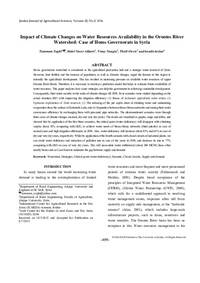Impact of Climate Changes on Water Resources Availability in the Orontes River Watershed: Case of Homs Governorate in Syria

Authors:
Homs governorate watershed is considered as the agricultural production hub and a strategic water reservoir of Syria. However, land fertility and the increase of population, as well as climatic changes, urged the farmers in this region to intensify the agricultural development. This has resulted in increasing pressure on available water resources of upper Orontes River Basin. Therefore, it is necessary to develop a prediction model that helps to estimate future availability of water resources. This paper analyzes how some strategies can help the government in achieving sustainable development. Consequently, their water security in the wake of climate changes till 2050. Four scenarios were studied depending on the actual situation (RF) with improving the irrigation efficiency: (1) Reuse of reclaimed agricultural water return, (2) Optimum exploitation of Zeita reservoir, (3) The reducing of the per capita share of drinking water and minimizing evaporation from the surface of Kattenieh Lake, and (4) Separation between Homs-Hama networks and raising their water conveyance efficiency by exchanging them with pressured pipe networks. The aforementioned scenarios were through three cases of climate changes (normal, dry and very dry years). The results are visualized as graphs, maps and tables, and showed that by application of the first three scenarios, the critical point (water deficiency) will disappear with obtaining surplus about 38% comparing with (RF), to achieve water needs of Homs-Hama networks (third priority) in case of normal years and high irrigation efficiencies in 2050. Also, water deficiency will decrease about 93% and 65% in case of dry and very dry years, respectively. While by application of the fourth scenario with closed circuits of industrial plants, we can avoid water deficiency and reduction of pollution rate in case of dry years in 2050, and decrease its rate to 77% comparing with (RF) in case of very dry years. This will necessitate water withdrawal (about 200 MCM) from other nearby basin such as Coast basin to minimize the gap between supply and demand.
